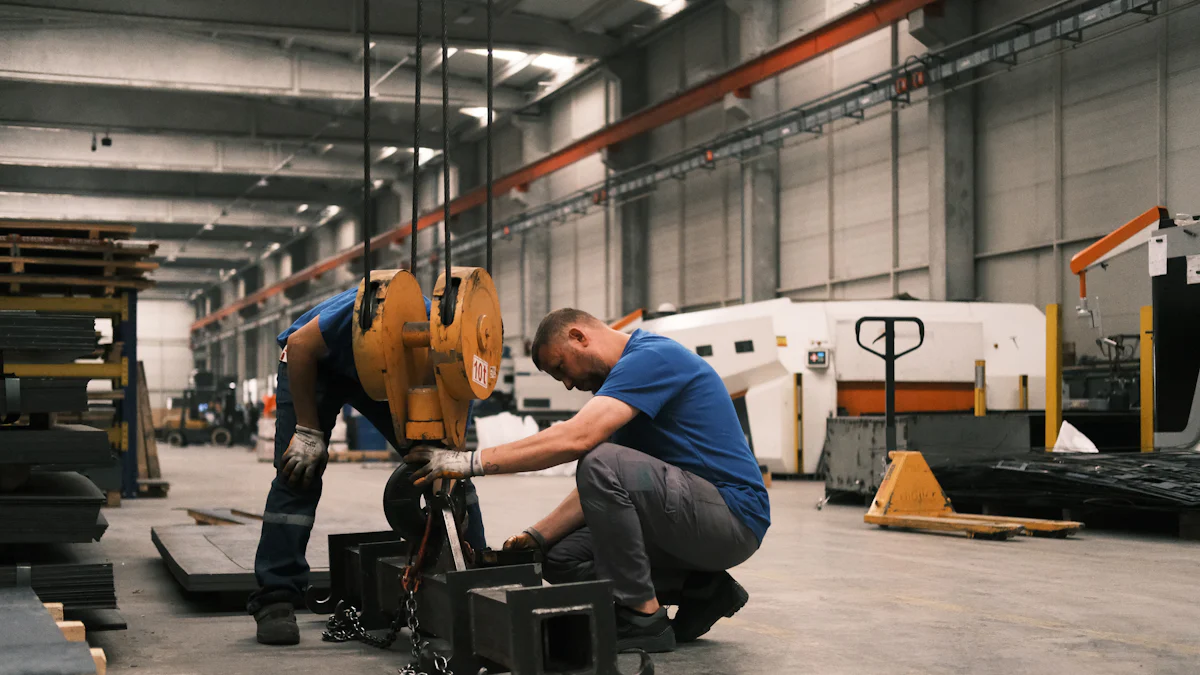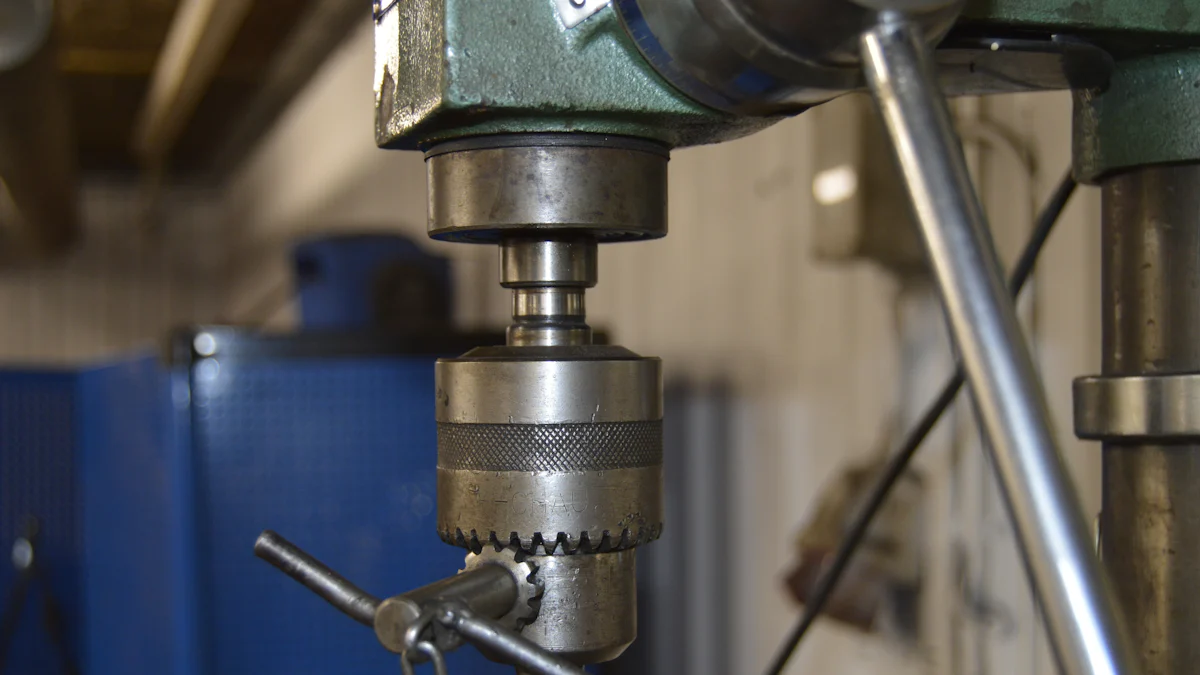
News
Canroon's Induction Heating solutions redefine efficiency and precision in Induction Welding Brazing ,induction heating machine applications. These systems offer remarkable Induction heating efficiency, ensuring substantial energy savings. By utilizing High frequency induction heating machine technology, Canroon achieves precise heating control, minimizing waste and maximizing output. The IGBT High Efficiency Induction Heater provides rapid, localized heating, reducing energy consumption significantly. This portable induction heater heating system adapts seamlessly to various industrial needs, from induction brazing machine operations to heating inductor applications. ADAM MORRISON highlights the versatility of Canroon's Induction technology, making it a preferred choice across industries.

Understanding Induction Heating
Induction heating stands as a pivotal technology in modern industrial applications, offering unparalleled precision and efficiency. This section delves into the principles and technical aspects of induction heating, shedding light on its transformative impact on welding and brazing processes.
Principles of Induction Heating
Induction heating operates on the fundamental principle of electromagnetic induction, where an alternating current passes through a coil, generating a magnetic field. This field induces electric currents within a conductive material, leading to heat generation. Two primary mechanisms drive this process:
Hysteresis Heating
Hysteresis heating occurs in ferromagnetic materials. As the magnetic field fluctuates, the magnetic domains within the material realign, causing internal friction. This friction generates heat. The efficiency of hysteresis heating depends on the material's properties and its Curie point, the temperature at which it loses its magnetic properties. Once the Curie point is reached, hysteresis heating ceases, making it crucial for precise temperature control.
Eddy Current Heating
Eddy Current Heating plays a significant role in induction heating. When the magnetic field penetrates the conductive material, it induces circular currents known as eddy currents. These currents flow against the material's resistance, producing heat. Eddy Current Heating is highly efficient, especially in non-magnetic materials, as it allows for rapid and uniform heating. The depth of penetration and heating efficiency depend on the material's electrical conductivity and the frequency of the alternating current.
Technical Aspects
Understanding the technical aspects of induction heating is essential for optimizing its application in industrial settings. Key considerations include power requirements and inductor design.
Power Requirements
The power requirements for induction heating systems vary based on the material and the desired heating rate. High-frequency induction heating machines offer precise control over the heating process, allowing for energy-efficient operations. By adjusting the power output, operators can achieve the desired temperature quickly, minimizing energy consumption and enhancing process efficiency.
Inductor Design
The design of the inductor, or the coil, is critical to the effectiveness of induction heating. The coil's shape, size, and material influence the magnetic field's strength and distribution. A well-designed inductor ensures uniform heating, reducing the risk of overheating or underheating specific areas. Customizable solutions allow for the adaptation of inductor designs to meet specific industrial needs, ensuring optimal performance across various applications.
Induction heating's ability to provide precise temperature control, rapid heating rates, and energy efficiency makes it a preferred choice in many industries. Its versatility and adaptability contribute to improved product quality and resource utilization, reinforcing its role as a cornerstone of modern manufacturing.
Process Controls in Induction Heating
Temperature Control
Importance of Precise Temperature Management
Induction heating excels in providing precise temperature control, a critical factor in ensuring consistent quality and repeatability in industrial processes. The ability to accurately manage temperature profiles allows for controlled heat distribution, which is essential in applications requiring specific temperature gradients or material properties. This precision ensures that each component receives the exact amount of heat needed, reducing the risk of defects and enhancing product quality.
"Induction heating provides precise temperature control and uniform heating, ensuring consistent quality and repeatability in industrial processes."
Precise temperature management also plays a vital role in energy efficiency. By maintaining the desired temperature with minimal fluctuations, induction heating systems minimize energy waste, leading to cost savings and reduced environmental impact.
Tools and Technologies Used
Various tools and technologies facilitate precise temperature control in induction heating systems. Advanced sensors and controllers monitor and adjust the power, frequency, and duration of the electromagnetic field. These components work together to maintain the desired temperature, ensuring accurate and responsive adjustments.
Modern induction heating systems often incorporate Programmable Logic Controllers (PLCs) and Human-Machine Interfaces (HMIs). These technologies enable operators to set precise parameters and monitor the process in real-time. The integration of these tools enhances the system's ability to deliver consistent results, even in complex applications.
Automation and Monitoring
Benefits of Automated Systems
Automation in induction heating systems offers numerous benefits, including increased efficiency and consistency. Automated systems reduce the need for manual intervention, minimizing the risk of human error and ensuring that each process follows the same parameters. This consistency leads to higher-quality products and improved production rates.
Automated systems also allow for seamless integration into existing production lines. This integration enables precise process control, monitoring, and data logging, ensuring reliable results across various applications.
"Induction heating systems can be seamlessly integrated into automated production lines, enabling precise process control, monitoring, and data logging."
Real-time Monitoring Capabilities
Real-time monitoring capabilities are a crucial aspect of modern induction heating systems. These capabilities allow operators to track the process as it happens, making immediate adjustments if necessary. Real-time data provides valuable insights into the system's performance, helping identify areas for improvement and optimize the process.
The ability to monitor the process in real-time also enhances safety. Operators can quickly detect any anomalies or deviations from the set parameters, allowing for prompt corrective actions. This proactive approach reduces the risk of accidents and equipment damage, ensuring a safe working environment.
Applications in Welding and Brazing

Flux and Fluxless Brazing
In the realm of brazing applications, the choice between flux and fluxless methods plays a crucial role. Each method offers distinct advantages and is suitable for specific scenarios.
Advantages of Fluxless Brazing
Fluxless brazing stands out for its ability to produce clean joints without the need for post-brazing cleaning. This method often employs a controlled atmosphere, such as a vacuum or inert gas, to prevent oxidation during the heating process. The absence of flux eliminates the risk of flux residue, which can compromise joint integrity. Fluxless brazing is particularly advantageous when working with copper filler metals, as it ensures a strong bond without contamination. This method is ideal for applications requiring high precision and cleanliness, such as in the automotive and aerospace industries.
Situations Requiring Flux
Despite the benefits of fluxless brazing, certain situations necessitate the use of flux. When heated parts are exposed to air, oxidation can occur, hindering the brazing process. Flux acts as a protective barrier, preventing oxidation and promoting the flow of filler metal. It is essential in scenarios where maintaining a controlled atmosphere is challenging. For instance, carbide cutting tools often rely on traditional mineral fluxes to ensure a robust bond. In these cases, flux facilitates the alloying of base and filler metals, ensuring a strong and durable joint.
Joint Design Considerations
The design of joints significantly impacts the success of induction brazing applications. Proper joint design ensures optimal heat distribution and filler metal flow, leading to strong and reliable connections.
Types of Joints Suitable for Induction Heating
Induction heating method is compatible with various joint types, each offering unique benefits. Lap joints, for example, provide a large surface area for filler metal adhesion, enhancing joint strength. Butt joints, on the other hand, allow for precise alignment and minimal filler metal usage. The choice of joint type depends on the specific requirements of the brazing process, including the materials involved and the desired joint strength.
Design Tips for Optimal Results
To achieve optimal results in induction brazing applications, consider the following design tips:
Joint Clearance: Maintain a clearance between 0.002 to 0.005 inches for most induction brazing applications. This range ensures optimal joint strength and filler metal flow.
Surface Preparation: Thoroughly clean parts before heating to maximize alloying. Avoid relying on flux to compensate for poor surface preparation.
Material Compatibility: Choose filler metals that complement the base materials. For instance, copper filler metals work well with copper and brass components.
By adhering to these design principles, manufacturers can enhance the efficiency and reliability of their induction brazing process. Proper joint design not only improves product quality but also maximizes resource utilization, reinforcing the value of induction heating method in modern manufacturing.
Advantages of Canroon's Induction Heating Solutions
Energy Efficiency and Cost Savings
Canroon's induction heating solutions stand out for their remarkable energy efficiency. These systems significantly reduce energy consumption by utilizing advanced technology that optimizes the heating process. The induction heaters generate heat directly within the metal, minimizing energy loss. This method ensures that the energy used is efficiently converted into heat, leading to substantial savings.
Reduction in Energy Consumption
The reduction in energy consumption is a key advantage of Canroon's solutions. By focusing the heat precisely where needed, these systems avoid unnecessary energy expenditure. The induction process involves generating a magnetic field that induces a current within the metal. This current produces heat, allowing for rapid and efficient heating. The depth of penetration and the frequency of the current can be adjusted to suit different materials, such as copper or steel, ensuring optimal energy use.
Lower Operational Costs
Lower operational costs naturally follow from reduced energy consumption. Canroon's induction heating solutions require less energy to achieve the desired heating levels, which translates into cost savings for businesses. The efficiency of the heating process reduces the time needed to heat materials, further decreasing operational expenses. Companies benefit from lower electricity bills and reduced maintenance costs due to the durability and reliability of Canroon's equipment.
Versatility and Adaptability
Canroon's induction heating solutions offer unparalleled versatility and adaptability, making them suitable for a wide range of industrial applications. These systems can be customized to meet the specific needs of different industries, providing tailored solutions that enhance productivity and efficiency.
Customizable Solutions for Different Industries
The ability to customize solutions is a significant advantage of Canroon's induction heating technology. Industries such as automotive, aerospace, and manufacturing can benefit from systems designed to meet their unique requirements. Whether it's brazing copper components or welding steel parts, Canroon's solutions provide the flexibility needed to handle diverse tasks. The depth of heating and the frequency of the current can be adjusted to match the specific properties of the materials being heated, ensuring optimal performance.
Ease of Integration into Existing Systems
Ease of integration into existing systems is another notable feature of Canroon's induction heating solutions. These systems can seamlessly fit into current production lines, enhancing efficiency without requiring extensive modifications. The compact design and user-friendly interface make it easy for operators to incorporate the equipment into their workflows. The electrical components are designed for compatibility with various industrial setups, ensuring smooth operation and minimal disruption.
In summary, Canroon's induction heating solutions offer significant advantages in terms of energy efficiency, cost savings, versatility, and adaptability. By reducing energy consumption and operational costs, these systems provide a cost-effective solution for businesses. Their customizable nature and ease of integration make them an ideal choice for industries seeking to enhance their heating processes.
Canroon's induction heating solutions offer numerous benefits for welding and brazing applications. These systems enhance efficiency and precision, leading to significant energy savings and reduced operational costs. Users like Ms. Sandy have praised the reliability and speed of Canroon's products, highlighting their excellent quality. The CR2000 model, for instance, provides accurate temperature control and a 100% duty cycle, making it suitable for various industrial tasks. Businesses seeking to improve their heating processes should consider Canroon's innovative solutions for their versatility and adaptability across different applications.
Previous:
Next:
Please give us a message